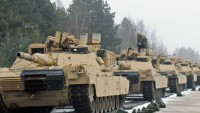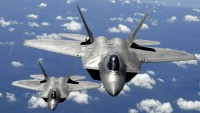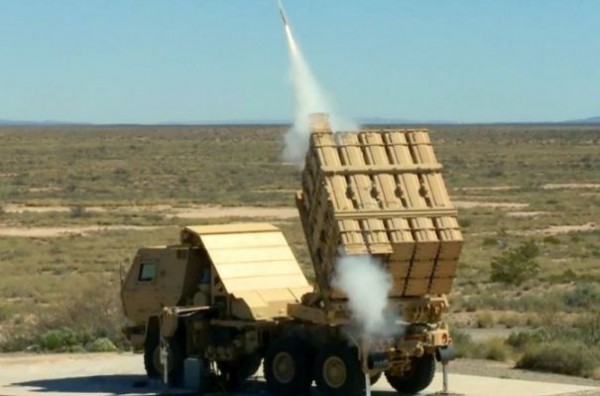US Army Rapidly Ramping-up Short Range Air Defense Capability to Cope with Russia and China
| Arthur Dominic Villasanta | | Feb 15, 2017 08:33 AM EST |
(Photo : US Army) MML test.
The U.S. Army is scrambling to close its "short-range air defense gap," key vulnerability that's leaving its troops more vulnerable to enemy air strikes in conventional battles.
A report presented to Congress in 2016 by the National Commission on the Future of the Army concluded the Army is faced with an "unacceptable modernization shortfall" in SHORAD or Short-Range Air Defense capability.
Like Us on Facebook
The renewed emphasis on a more robust SHORAD capability is being driven by the reality a war against Russia, which has a credible aerial ground attack capability, is a possibility in Europe.
Col. Greg Brady, the fires division chief for Training and Doctrine Command at Army headquarters, said the Army has nine battalions with SHORAD capabilities compared to 26 in 2004. Of those nine battalions, seven with the Army National Guard while two are with the active force.
The insurgencies in Afghanistan and Iraq forced the Army to focus and prioritize other weapon systems at the expense of its SHORAD capabilities. That is no longer the case since the clear threats to the U.S. now are the conventional armies of Russia and China.
To erase this gap, the army has announced its goal is to field SHORAD capability to Europe in fiscal year 2018, said Lt. Gen. James H. Dickinson, Commander of the U.S. Army Space and Missile Defense Command/Army Forces Strategic Command and Joint Functional Component Command for Integrated Missile Defense.
One of the options open to the army to plug this hole is to develop the Multi-Mission Launcher (MML),a launcher than can fire a wide variety of missiles. MML will be integrated into the Indirect Fire Protection Capability designed to defeat unmanned aerial systems, rockets, artillery, mortars and cruise missiles.
MML last month successfully completed another round of test firings. The army fired a Miniature Hit-to-Kill Missile (MHTK); an AIM-9X Sidewinder and an AGM-114 Hellfire missile from an MML.
The MML launcher can rotate 360 degrees and elevate from 0-90 degrees to identify and knock-out approaching fire from any direction or angle. It consists of 15 tubes, each of which can hold either a single large interceptor or multiple smaller interceptors.
MML is a truck-mounted weapon that's part of an infantry protection program called Indirect Fire Protection Capability Increment 2-Intercept, or IFPC Inc 2-I. This system uses a Sentinel radar and fire control technology to identify and destroy incoming enemy fire and protect friendly forces.
MML works in tandem with radar and fire-control software to identify, track, pinpoint and destroy approaching enemy air threats with an interceptor missile.
The army said MML gives its soldiers deployed at forward operating bases the capability to defend themselves from attacking enemy fire. It said MML will greatly help protect U.S. infantry in harm's way and under the most difficult battlespace operating conditions.
Brig. Gen. Christopher Spillman, Commandant of the Air Defense Artillery School, and his team noticed the use of Unmanned Aerial Systems by U.S. enemies was spreading and determined a new system was needed to combat the threat.
TagsU.S. Army, short-range air defense ga, SHORAD, Short-Range Air Defense, Multi-Mission Launcher
©2015 Chinatopix All rights reserved. Do not reproduce without permission
 US Keeps Pouring Men and Materiel into Europe to Bolster NATO against Russia
US Keeps Pouring Men and Materiel into Europe to Bolster NATO against Russia German and NATO Troops Deploy to Lithuania; Stand with Baltic States against Russia
German and NATO Troops Deploy to Lithuania; Stand with Baltic States against Russia China’s Utter Defeat in a War vs the US Might Trigger Civil War in China and Destruction of the Communist Party
China’s Utter Defeat in a War vs the US Might Trigger Civil War in China and Destruction of the Communist Party US Army will Transform Quad-Copters into Anti-Tank Weapons
US Army will Transform Quad-Copters into Anti-Tank Weapons
EDITOR'S PICKS
-

Did the Trump administration just announce plans for a trade war with ‘hostile’ China and Russia?
-

US Senate passes Taiwan travel bill slammed by China
-

As Yan Sihong’s family grieves, here are other Chinese students who went missing abroad. Some have never been found
-

Beijing blasts Western critics who ‘smear China’ with the term sharp power
-

China Envoy Seeks to Defuse Tensions With U.S. as a Trade War Brews
-

Singapore's Deputy PM Provides Bitcoin Vote of Confidence Amid China's Blanket Bans
-

China warns investors over risks in overseas virtual currency trading
-

Chinese government most trustworthy: survey
-

Kashima Antlers On Course For Back-To-Back Titles
MOST POPULAR
LATEST NEWS
Zhou Yongkang: China's Former Security Chief Sentenced to Life in Prison

China's former Chief of the Ministry of Public Security, Zhou Yongkang, has been given a life sentence after he was found guilty of abusing his office, bribery and deliberately ... Full Article
TRENDING STORY

China Pork Prices Expected to Stabilize As The Supplies Recover

Elephone P9000 Smartphone is now on Sale on Amazon India

There's a Big Chance Cliffhangers Won't Still Be Resolved When Grey's Anatomy Season 13 Returns

Supreme Court Ruled on Samsung vs Apple Dispute for Patent Infringement

Microsoft Surface Pro 5 Rumors and Release Date: What is the Latest?










